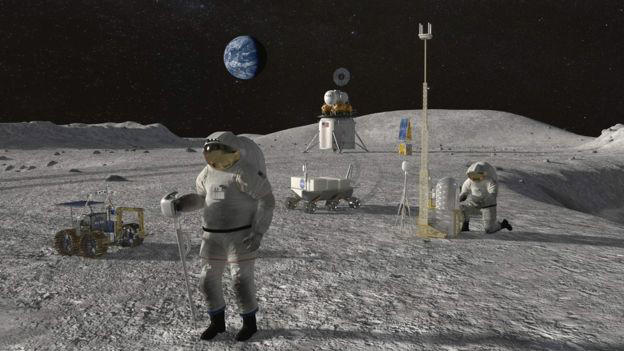USA aims for humans on Moon in five years
US Vice-President Mike Pence has said he wants Nasa to return astronauts to the Moon within five years.
Referencing China's recent successful robotic mission to the far side, he said: "We're in a space race today, just as we were in the 1960s."
Nasa had already been planning to return to the Moon, but Mr Pence's announcement accelerates the timeline.
He was speaking at a meeting of the National Space Council in Huntsville, Alabama.
"It is the stated policy of this administration and the United States of America to return American astronauts to the Moon within the next five years," Mr Pence told the audience.
"Just as the United States was the first nation to reach the Moon in the 20th Century, so too, we will be the first nation to return astronauts to the Moon in the 21st Century.
Nasa will target the lunar south pole, a challenging region with areas that are in permanent darkness.
But the pole also holds reserves of water-ice, which Nasa wants to turn into fuel for spacecraft.
"It's time for the next giant leap," Mr Pence said, alluding to the words spoken by the first Moonwalker Neil Armstrong in 1969.
He added: "That next giant leap is to return American astronauts to the Moon within the next five years by any means necessary, and to establish a permanent presence on the Moon and prepare to put American astronauts on Mars."
"In order to accomplish this, Nasa must transform itself into a leaner, more accountable and more agile organisation."
The US space agency's administrator Jim Bridenstine said in a Twitter post: "Challenge accepted. Now let's get to work."
Nasa had previously aimed to return astronauts to the lunar surface by the year 2028, after first putting a space station, called Gateway, in orbit around the Moon by 2024.
Few commentators doubt that the timeline will be extremely challenging.
Crucial to the lunar plans will be a heavy-lift rocket that can loft the massive hardware required for a lunar journey and landing.
Nasa has been building its own launcher, called the Space Launch System (SLS). But the project has been hit by delays and cost overruns.
Mr Bridenstine had been considering moving forward with a less powerful commercial rocket, perhaps a vehicle built by SpaceX or the Boeing-Lockheed Martin partnership United Launch Alliance, to get an uncrewed capsule into space by 2020.
But after Tuesday's announcement, Nasa's administrator said he was sure Nasa could achieve a successful SLS flight by next year.
The Orion capsule, built by Lockheed Martin, will be the main spacecraft for transferring astronauts to lunar orbit.
But work has not yet started on building a lunar lander.
Pence threatened to use commercial launch systems or to look to other partners if Nasa is not ready in time.
"To be clear, we're not committed to anyone's contract. If our current contractors can't meet this objective, then we will find ones that will," Mr Pence said.
Source: BBC
St Josephs Primary School, 1a Slate St, Cullingtree Road, Belfast BT12 4LD Phone: 028 9032 3683
 Menu
Menu

